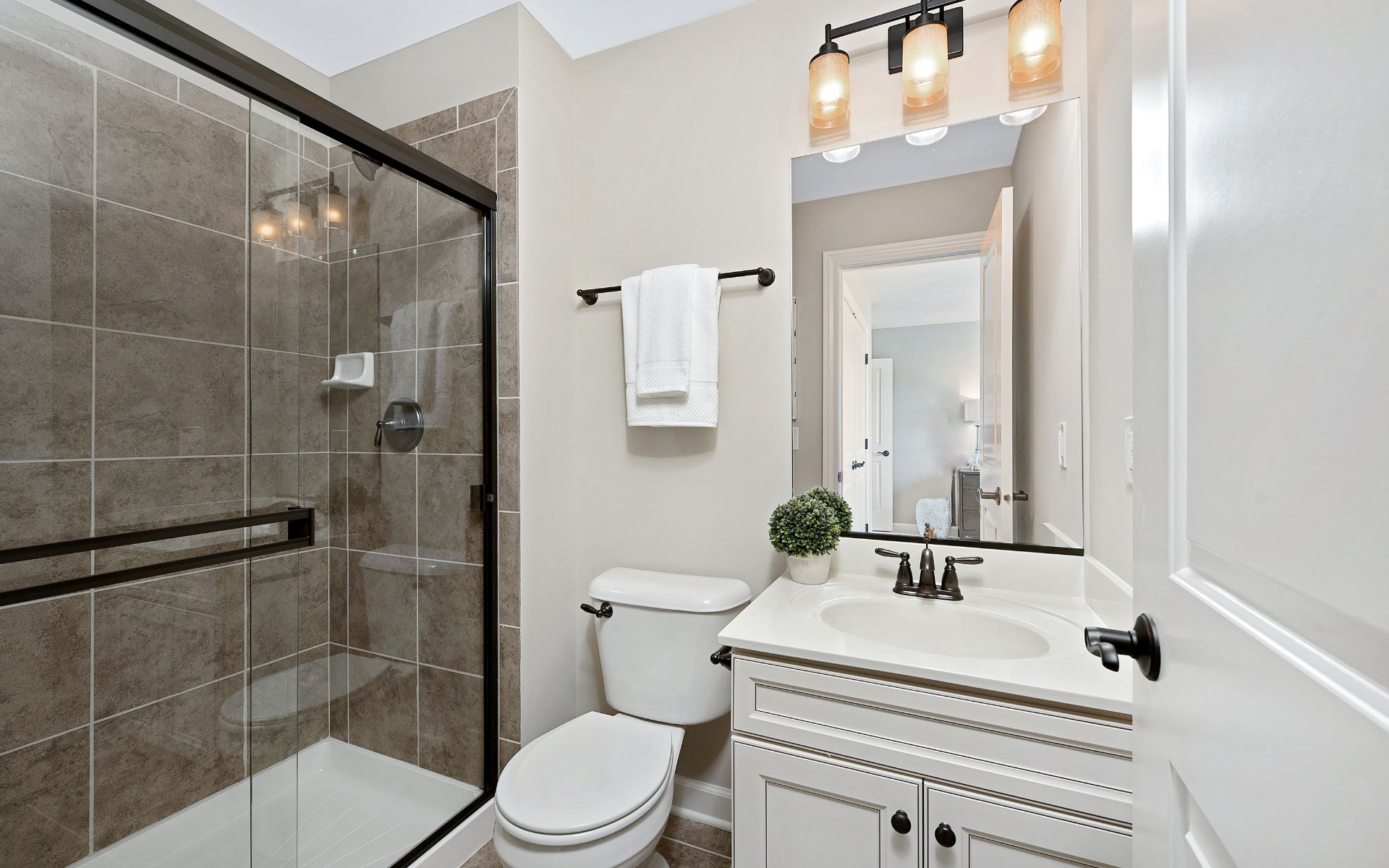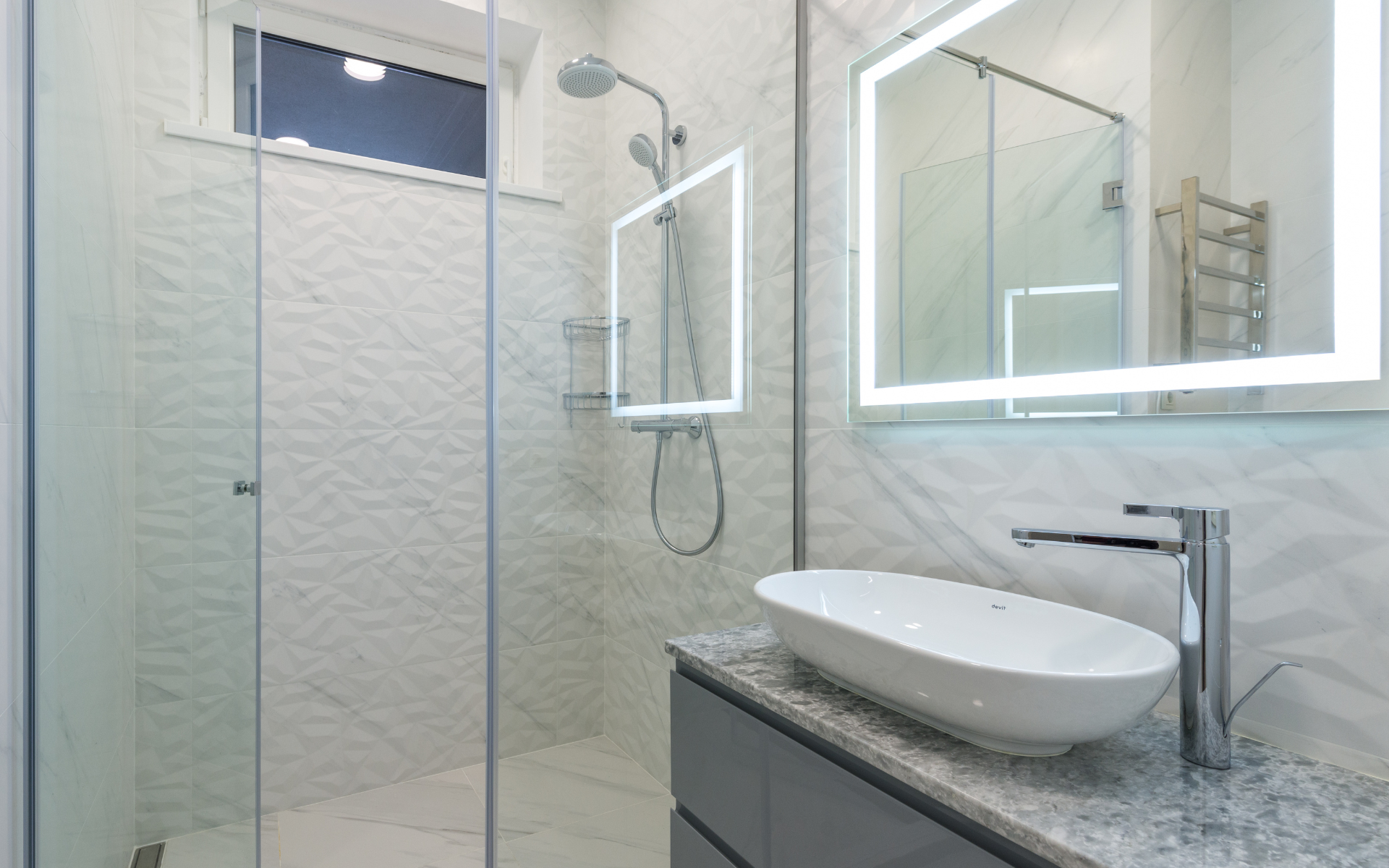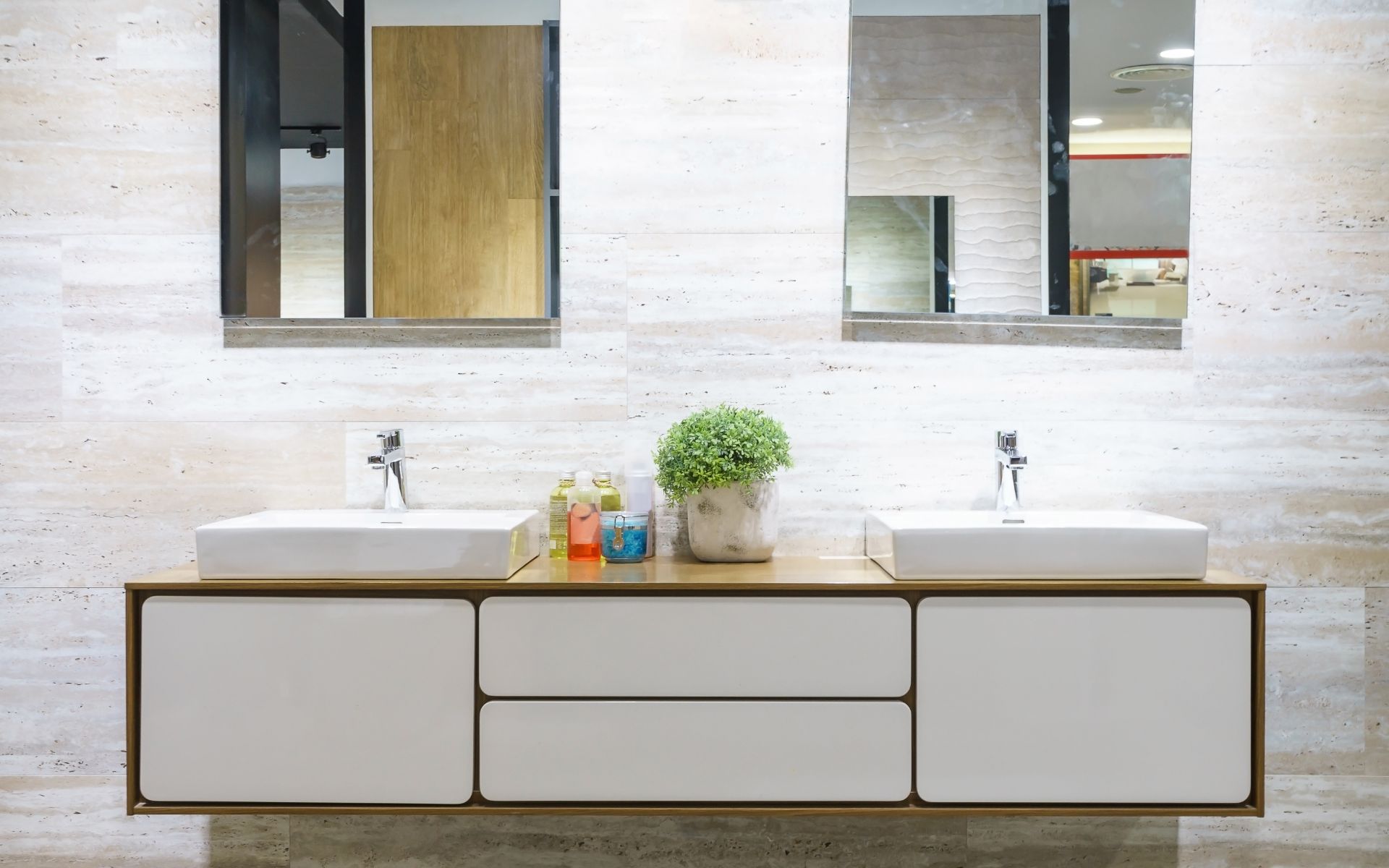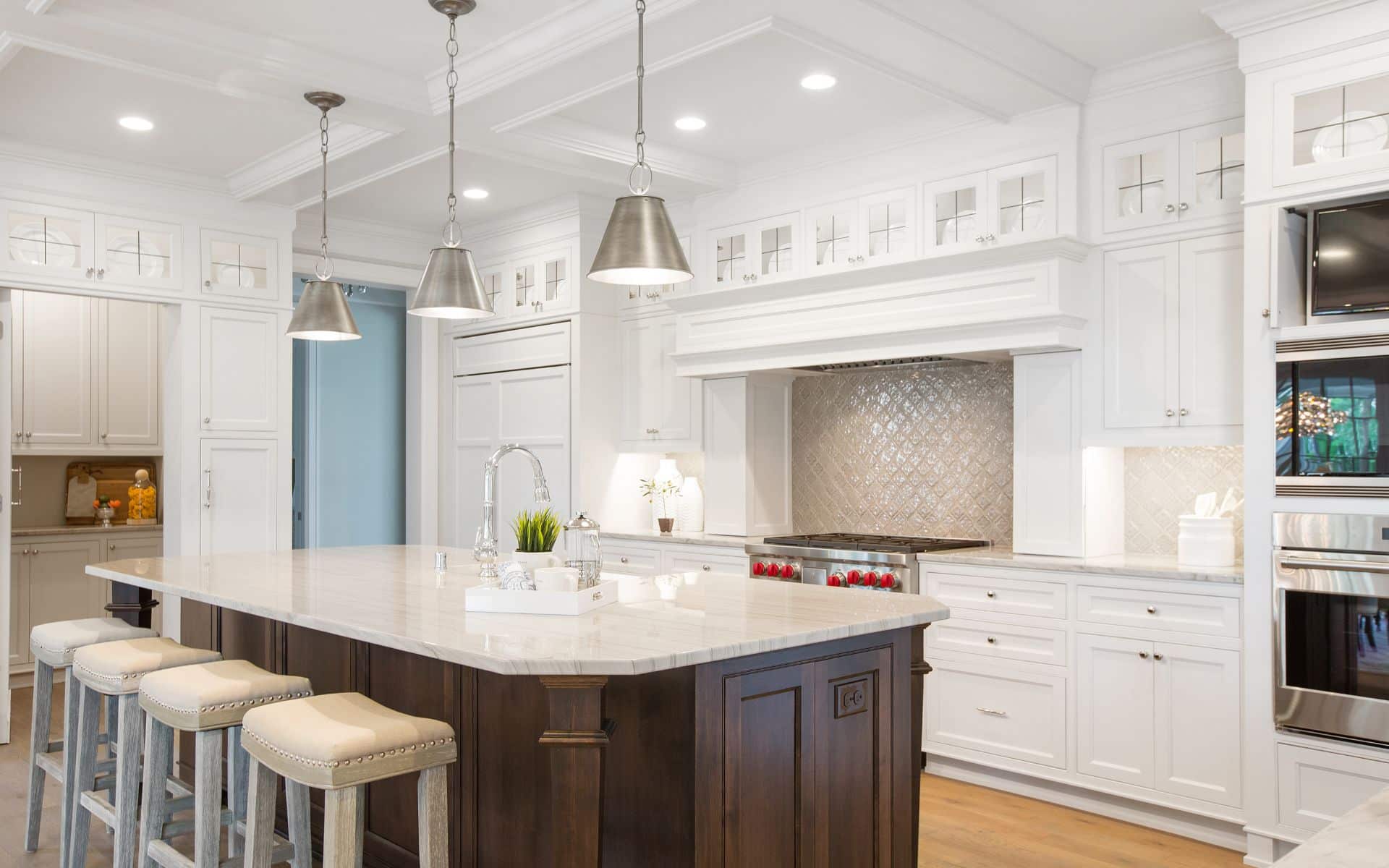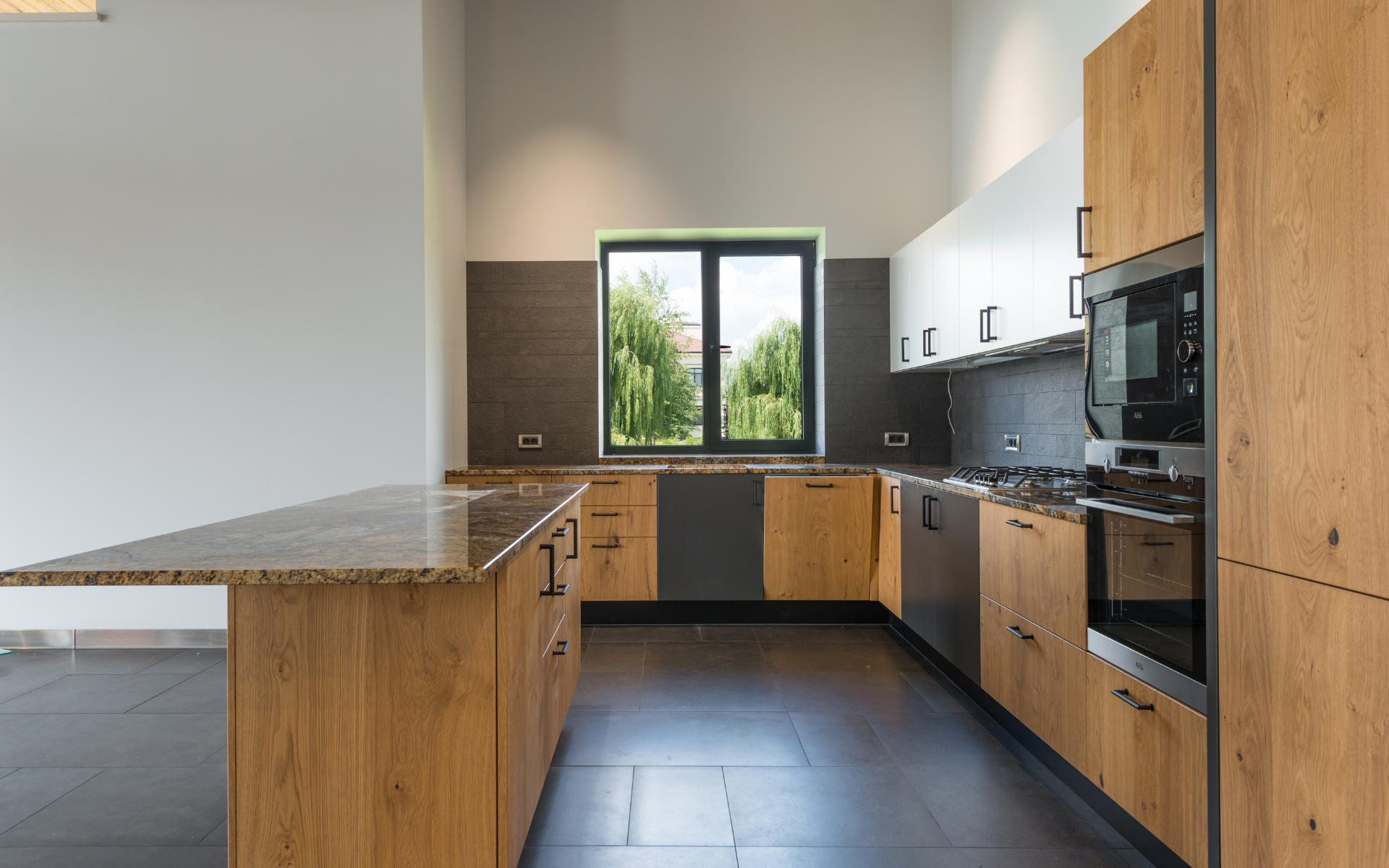Looking for small bathroom ideas to help maximize your limited space?
Bathrooms are often one of the smallest rooms in a home, but that doesn’t mean you have to sacrifice style or functionality. With clever layouts, storage solutions, and design elements, even the tiniest bathrooms can be both beautiful and highly functional.
Before hiring a kitchen and bath contractor, we’ll first explore 40+ smart small bathroom design ideas to help you optimize every inch of your compact bathroom.
From space-saving sinks and toilets to storage solutions and layout ideas, these tips will help you transform your tiny bathroom into a well-designed oasis. Let’s dive in!
Optimize Small Spaces with Clever Layouts and Arrangements
One of the keys to maximizing a small bathroom is clever layout and arrangement. Strategic placement of fixtures and amenities can help open up floor space and prevent the room from feeling overly cramped.
Here are some layout ideas to make the most of your compact bathroom footprint.
Choose Space-Saving Fixtures
When dealing with a tiny bathroom remodel, every inch of extra space matters. Selecting smaller yet functional fixtures can help open up valuable floor space and prevent a crowded feel. Some space-saving options include:
Wall-Hung Toilets
Wall-mounted, tankless toilets save space by eliminating the bulky tank. Just be sure your bathroom walls are reinforced to handle the weight.
Pedestal or Wall-Mounted Sinks
Pedestal sinks have a small footprint, while wall-mounted sinks free up counter space. Just be sure to have enough open shelving for toiletries.
Corner Showers
A corner shower utilizes wasted space and makes an existing footprint feel larger. Use a curved front shower curtain rod and glass doors to enhance the roomy feel.
Compact Bathtubs
Shorter and narrower tubs (or a tub-shower combo) can save several precious square feet. Look for designs around 60 inches long and 30 inches wide.
Create Visual Spaciousness with Mirrored Walls
Strategically placed mirrors can instantly make a small bathroom feel more spacious. Mirrored walls reflect light and create the illusion of a larger room.
For optimum openness, install mirrors across from the windows and opposite the doorway. Avoid placing mirrors directly adjacent to each other, as this can create a disorienting funhouse effect.
Install Glass Shower Doors
Clear glass shower doors maintain an airy, open feel in a small bathroom. Frameless glass design keeps the focus on the tile rather than the shower enclosure.
For safety, choose tempered glass doors, which are more resistant to breaking. Using the same tiles or decor inside and outside the shower area also helps the entire space appear bigger.
Shower and Bath Features
Showers and tubs should function beautifully without dominating the space:
- Frameless glass shower doors maintain an open, airy feel compared to shower curtains.
- Consider a wet room-style walk-in shower for a seamless look from wall to wall.
- Floating double vanities allow his-and-her sinks without bulky cabinetry underneath.
- Look for space-saving tub designs around 60″ long. Or install a tub/shower combo.
- Include recessed shelves or niches in shower walls for shampoo, soap, and razors.
Float the Vanity Away From the Walls
Floating vanities can visually expand floor space since the design eliminates bulky cabinets underneath. For small bathrooms, choose a narrow floating vanity around 24 to 30 inches wide.
Install a large mirror above to balance the proportions and maximize reflective light.
Accentuate Vertical Space
In a compact bathroom, utilize vertical space to further add storage space and amenities. Some ideas include:
- Tall narrow cabinets
- Recessed shelves or niches in shower walls
- Medicine cabinets recessed into the wall
- Wall-mounted floating shelves
- Towel racks mounted high on walls
- Full-height mirrors
Going vertical takes advantage of often-overlooked space while keeping the floor and traffic areas open.
Maximizing Wall Space
Wall space is prime real estate in a tiny bathroom. Take advantage of every inch with these ideas:
Install wall-mounted cabinets near the ceiling for extra storage. Choose glass-front cabinets to maintain an open feel.
Floating shelves mounted at varying heights provide open display space for towels, toiletries, and décor. Stagger taller and shorter shelves for versatility.
Recessed niches built into shower walls or above the toilet create useful storage nooks. Just be sure to waterproof any niches in the shower.
Floor-to-ceiling towers of cabinetry in unused corners add ample hidden storage. Include drawers, shelves, and hanging bars.
Wall mount or recess accessories like towel bars, toilet paper holders, and robe hooks for minimal visual clutter.
Use these tips to make more space and prevent wasted space:
- Arrange fixtures tightly along walls instead of scattered about to keep floor space open.
- Floating shelves mounted high utilize vertical wall space instead of taking up counter area.
- Tuck narrow storage cabinets into unused spaces above the toilet or next to vanities.
- Convert empty corners into built-in vertical storage with cabinets from floor to ceiling.
Optimizing Floor Space
Careful floor planning is key in a compact bathroom. Maximize every square foot with these floor space tips:
Arrange fixtures and features along the perimeter of the room rather than scattered throughout. This keeps floor and traffic areas as open as possible.
Floating vanities with undermount sinks open up floor space compared to traditional cabinetry. Opt for narrow 24-30 inch vanities.
Pedestal sinks have a tiny footprint. Just be sure to allow for open shelving nearby for toiletries and towels.
Place benches and stools that fold up against the wall when not in use. Only unfold when needed.
A curved shower rod adds several inches of elbow room compared to a straight rod. Use clear shower curtains.
Kickspace lighting illuminates tight areas under floating vanities and cabinets for safety.
This Architectural Digest piece provides creative small bathroom solutions from top designers. Strategies covered include opening up floor space with pedestal sinks and floating vanities, building in hidden storage with custom cabinets/shelving, using pocket or sliding doors, installing large-scale tiles to expand walls, maximizing natural light, and more.
Creative Storage Solutions for Tiny Bathrooms
This HGTV article shares excellent small bathroom ideas focused on lighting, storage, layouts, and visual tricks to make a compact space feel larger. Key tips include using light colors throughout, adding windows/skylights, using wall-mounted fixtures, including multifunctional furnishings, and utilizing vertical storage space.
Lack of storage space is one of the biggest complaints in small bathrooms.
However, with some clever solutions, you can tuck away all your toiletries, towels, and necessities – even in a tiny space. Here are some innovative storage ideas for compact bathrooms:
Optimize Wall Storage
Take advantage of every inch of available wall space. Install shallow floating shelves or wall-mounted cabinets high up near the ceiling.
Choose glass-front cabinets to maintain an airy feel while hiding necessities. Don’t forget the inside of cabinet doors – use them to mount shelves or towel bars.
Add Hidden Storage Niches
Build out small recessed niches in unused wall areas to stash bathroom necessities. Great spots include above the toilet, inside the shower enclosure, or on either side of floating vanities.
Make sure to waterproof any niches in the shower or tub area.
Use Slim Rolling Storage
Slim rolling carts provide bathroom storage while maximizing floor space. Look for narrow designs around 10 to 14 inches wide.
A rolling cart tucked in an out-of-the-way spot can hold towels, toilet paper, and other essentials while freeing up cabinet space for linens or cleaning supplies.
Install Space-Saving Medicine Cabinets
Recessed medicine cabinets provide discreet storage without protruding into the room. Look for shallow cabinets with double doors that use interior space efficiently.
Consider medicine cabinets with built-in shelves, mirrors, and lighting for optimal use of space.
Add Multipurpose Furniture
Make every piece of furniture multitask. A bathroom storage bench can provide seating and hide linens or toiletries inside. Or look for a sink vanity with built-in hampers to corral dirty laundry.
Even the toilet tank can get into the storage action – consider a tank-topper bowl filled with toiletries or extra TP.
Use Wall-Mounted Shelving
Keep the floor and traffic areas clear by installing shelves on walls or inside shower enclosures. Floating shelves and a towel rack with ladders add storage without cluttering up limited floor space.
Mount shelves at varying heights to accommodate different-sized items.
Smart storage hides clutter and necessities:
- Baskets, bins, and drawers neatly corral toiletries on open shelves instead of cluttered piles.
- Shallow floating shelves have a small footprint yet provide open display space.
- Medicine cabinets recessed into walls are discreet storage solutions.
Design Elements to Brighten and Modernize Small Bathrooms
Just because a bathroom is small doesn’t mean it has to look dark or dated. The right design elements can make a compact bathroom feel fresh, light, and modern. When remodeling a tiny bath, keep these tips in mind:
Install Plenty of Lighting
Proper lighting is key to making a small bathroom remodel feel bright and airy. Add lighting in multiple areas, including overhead ceiling fixtures, recessed can lights, illuminated medicine cabinets, and accent lighting.
Light reflective surfaces like mirrors, glass shower doors, and tile walls to maximize brightness.
Choosing a Light Neutral Backdrop
Picking a light, neutral shade for your walls, flooring, and cabinetry creates an airy, spacious look in a small bathroom. Consider these soothing, versatile background colors:
- White – Bright pure white makes the space feel clean and expansive
- Off-White – Warmer tones like almond cream add subtle color
- Light Gray – Misty shades like pearl gray work as modern neutrals
Adding Pops of Color
Include small doses of color through accents and décor against the light backdrop:
Pale Blues
Soothing aqua or sky blue in towels, rugs, shower curtains
Light Greens
Olive and sage greens complement the white cabinetry
Soft Lavenders
Lilac or lavender linens and artwork add delicate color
Choosing the Right Tile
Tile is a great way to introduce color, texture, and visual interest to a small bathroom. Be strategic with tile choices to enhance the feeling of space.
1. Light Marble or Glass Mosaic Tiles
- Elegant and bright white marble tile catches the light beautifully in small spaces.
- Glass mosaic tile adds a pop of color or shimmery accent. Keep grout lines thin.
- Use marble or glass mosaic tiles sparingly on one wall, the shower floor, or as an inset detail.
- Pair with neutral walls and flooring so the mosaic tile can stand out.
2. Classic White Subway Tile
- White 3×6 subway tile is a versatile and timeless option for small bathrooms.
- The rectangular shape and thin grout lines create the perception of length and space.
- Use subway tile on the tub/shower surround, as an accent stripe, or on the entire wall area.
- Pair with light marble mosaic flooring for contrast.
3. Warm Beige and Gray Natural Stone or Porcelain
- Natural stone like travertine adds texture and a soothing, spa-like feel.
- Porcelain tile mimics the look of stone for less maintenance. Go for light beige, gray, or taupe colors.
- Use large-scale stone or porcelain tile on the floors and in the walk-in shower area.
- Contrast with bright white subway tile on walls and tub/shower surround.
Other Tips:
Consider these tips when selecting tiles:
- Glossy ceramic walls and floor tiles reflect light to make the room feel brighter and larger.
- Subway, brick, or mosaic patterns on walls add visual texture. Keep floor tiles simpler.
- Use the same wall tiles vertically on the shower walls and horizontally on the floor for a streamlined look.
- Contrast glossy ceramic wall tiles with natural stone or porcelain floor tiles.
- Warm metallic mosaic tiles make an attractive accent wall or focal point.
- Use the same tile on walls and shower floor for a seamless look.
- For floor tile, select larger tiles and thin grout lines to expand the space.
- Avoid dark grout, which can make tile patterns look too busy in a small area.
Strategic use of tile transforms dead space in a small bathroom while enhancing the feeling of spaciousness.
Warming it Up With Natural Elements
Organic textures and greens prevent an all-white scheme from feeling sterile:
- Rattan Baskets and Wicker Shelves
- Linen or Cotton Shower Curtains
- Houseplants like Ferns, Orchids, or Air Plants
Using a mindful neutral color scheme with pops of color here and there keeps a small bathroom feeling fresh, bright, and inviting. The right colors can transform even the tiniest space.
Add Patterns and Texture
While light backgrounds maximize brightness, don’t be afraid to add some visual interest too. Opt for shower tiles or ceramic wall accents in natural stone, glass, or mosaic patterns.
Introduce texture with woven shower curtains, fuzzy bath mats, wicker baskets, and linen curtains. Just be sure to stick to a muted color scheme so the space doesn’t get too busy.
Choose Streamlined Fixtures and Furnishings
Bulky furnishings can quickly overwhelm a tiny bathroom. When possible, opt for sleek, compact, or wall-mounted fixtures with clean lines and a minimalist silhouette. A floating vanity, frameless glass shower door front, and recessed medicine cabinet maintain an airy, clutter-free aesthetic.
Create a Focal Point
Use one unique feature or standout accessory as a focal point so the tiny room doesn’t look flat or monotonous. This could be a textured tile accent wall, an eye-catching light fixture, wallpaper on one wall, or an unexpected pop of color. Keep the rest of the room neutral to let the focal feature shine.
Cohesive Design and Style
Aesthetic touches give small bathrooms personality:
- Hire an interior designer to creatively maximize every inch of available space.
- Add an eye-catching light fixture as a focal point, like a pendant above a tub.
- Weave in traditional fittings like embroidered shower curtains or distressed wood accents for character.
Let me know if you would like me to expand on any of these sections further!
Smart Layouts and Arrangements for Family and Guest Bathrooms
When it comes to small yet functional family or guest bathrooms, layout is especially important. Multiple people will need to seamlessly navigate getting ready in a compact space.
Here are some smart ideas for arranging multi-user small bathrooms:
Include Double Sinks
Allow two people to use the bathroom at once by including his or her sinks. Floating double vanities save space yet allow for privacy and efficiency. Make sure there is adequate lighting and mirrors for each sink.
Add a Fold-DownChanging Table
For a family bathroom, look for a change table or a fold-down changing station. Many feature a changing pad on one side and cabinet storage on the other to tuck away diapers and wipes. Mount to the wall or hide inside vanity cabinets.
Use Space-Saving Doors
Doors that fold, slide, or pocket into the wall minimize the amount of space they take up in a small bathroom. Barn-style sliding doors only require a few inches of wall space.
Pocket doors disappear entirely into the wall. Both options maintain an open feel when doors are open.
Design Flexible Tub Areas
Look for small tubs that can multitask, like a tub with removable sides that convert to a shower. Or install a tub-shower combo fitted with both a showerhead and tub faucet for versatility.
Use quality front shower heads and curtains that glide smoothly and tuck neatly out of the way.
Add a Fold-Out Bench
A fold-out bench or stool tucked into a corner gives users a place to sit while getting ready. Look for tri-fold designs attached to the wall or freestanding stools that slip under existing floating vanities.
Just be sure they don’t impede traffic flow when opened.
Clever Makeovers for Attic and Basement Bathrooms
Attic and basement bathrooms present unique small bathroom challenges with their cramped footprints, slanted ceilings, and lack of natural light. But even awkward attic or basement bathrooms can be transformed into stylish, functional oases. Here are some tips:
Use Freestanding Fixtures
Freestanding tubs and toilets are ideal for attics and basements where plumbing locations are fixed. Look for compact rectangular tubs about 52-60 inches long to tuck under angled ceilings. Keep traffic areas clear around fixtures.
Add Skylights and Extra Lighting
Make the most of natural light by installing skylights or light tubes to let sunshine filter into windowless attics or basements. Supplement with ample recessed lighting, illuminated mirrors, and fixtures. Paint walls and ceilings white to reflect light.
Work with Angled Architecture
Take advantage of the unique architecture. Use the slopes and angles to create built-in shelving for towels and toiletries. A Slanted ceiling also allows for taller cabinets on one side of the room. Just be sure to check head clearance.
Include Touchless Fixtures
In basement bathrooms, look for touchless sinks, toilets, and soap dispensers. Motion-activated fixtures are more hygienic for shared family or guest baths. They also eliminate the need for fumbling around in dim basements.
Add Radiant Floor Heating
Radiant floor heating keeps basement bathroom floors warm and inviting, even on cold subterranean concrete. Electric mats are easy to install under most tile, vinyl, and laminate floors. Just leave room for the toilet flange.
Creative Solutions for Converting a Powder Room into a bathroom
Powder rooms present fun small and bathroom design challenges with their tiny footprints. Often windowless, powder rooms need smart solutions to work in the basics. Here are some tips for converting powder rooms into petite yet practical bathrooms:
Use a Pedestal Sink
A pedestal sink is ideal for tiny powder rooms thanks to its small footprint. Be sure to include a mirror above and adequate open shelving for toiletries and hand towels near the sink since pedestals lack counter space.
Install a Wall-Hung Toilet
A tankless wall-hung toilet saves several square feet over a standard floor model. Make sure the wall is reinforced, and conceal the flushing mechanism creatively with a decorative cover box or side cabinet.
Add Pocket Doors
Pocket doors for powder room entryways provide privacy while saving space. The doors disappear entirely into recessed pockets in the wall, leaving hallways and floor areas open when closed. They also make a small room feel more spacious.
Include Plenty of Lighting
With no natural light, powder rooms rely solely on artificial lighting. Include ample overhead lighting plus undercabinet fixtures, illuminated mirrors, and nightlights. Strategically place mirrors to reflect and distribute light.
Build Custom Cabinetry
Take advantage of every inch by installing wall-to-wall cabinets for concealed storage. Custom built-ins with clever organization features (pull-out shelves, lazy susans, etc) provide ample storage without cluttering up precious floor space.
Choose Waterproof Flooring
Vinyl plank, luxury vinyl tile, or glass tile flooring are waterproof options ideal for the damp conditions of hardworking powder rooms. Choose large-scale dark patterns to make the petite space feel bigger. Match your shower floor tile for a seamless look.
Conclusion: Smart Ideas to Make the Most of Your Small Bathroom
As you can see, small bathrooms can be just as stylish and functional as larger rooms with clever layouts and strategic design choices. The key is to think efficiently with every decision – from space-saving fixtures to dual-purpose furnishings and built-ins.
Focus on creating visual spaciousness with mirrored walls, glass enclosures, wall-mounted fixtures, and light, airy colors. Then look for ways to add storage without sacrificing style, like recessed niches, medicine cabinets, and floating shelves. The right touches turn even the tiniest bath into a well-designed oasis.
With these 40+ smart space-maximizing ideas, you can transform your compact bathroom into a comfortable retreat. Our small bathroom ideas provide creative solutions to take on tiny baths, awkward attics, shared family bathrooms, and windowless powder rooms.
Just remember – every inch counts. Use these tips to make the very most of the limited square footage you have available.

